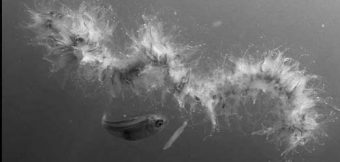Time to watch out – string jelly’s about
As yet the nearest sighting of these ‘strings of jelly’ to the Helford River has been a record in Falmouth Bay, but it is a species that is likely to make itself felt (literally) more often in the future. Yes, it’s probably another ‘southern’ species extending its range northwards. It is arguably the largest known invertebrate and hitherto there had been no recorded instances in Cornish seas.
 String jellfish www.divingimages.co.uk (c) Neil Hope
String jellfish www.divingimages.co.uk (c) Neil Hope
So what is this mysterious creature, the common names of which are ‘String Jelly’ or ‘Stinging Hydroid’? Both are descriptive, for it looks like a long piece of unravelling string, and they can sting, as many divers will testify. They are members of the genus Apolemia, the systematics of which are unclear and are thought to be A. uvaria, which was first described in 1815 by Lesuer. They are colonial animals (Siphonophores) related to the Portuguese Man-of-War (Physalia physalia) and the By-the-wind-sailor (Velella velella). In Norwegian seas one of the species is blue in colour and known as ‘Blue Fire’ and is known to have caused the death of fish in a salmon farm. The Cornish examples were all pink, although the colour may not be of significance.
Attention was first drawn to the ‘String Jelly’ by Rory Goodall, when he saw the strange creatures between Penzance and the Scillies. He informed Joana Doyle, Marine Officer of Cornwall Wildlife Trust, and Ray Dennis, who maintains the marine sightings database for Cornwall. Ray subsequently arranged for Dr Paul Gainey, a local marine expert, to see this phenomenon. He describes them as being present in tens of thousands, varying in length but mostly about 25cms long, but some extended specimens up to 2m in length. Some were seen releasing minute reproductive jellyfish (medusae). String jellies are known to form chains up to 20m or more in length. Each long chain is headed by a small buoyancy bladder (the equivalent bladder in Portuguese Man-of-War is shaped like a Cornish pasty), but the long string is very fragile and is soon broken up into shorter lengths, all of which are reproductively viable.
These short lengths have been described as like ragworms, and I now realise that some stinging strands previously reported to me were probably this species, but never has it been seen in such numbers as in 2007!
Stella Turk







